| Solar eclipse of January 14, 1907 | |
|---|---|
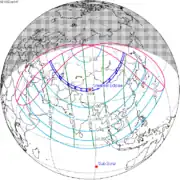 Map | |
| Type of eclipse | |
| Nature | Total |
| Gamma | 0.8628 |
| Magnitude | 1.0281 |
| Maximum eclipse | |
| Duration | 145 sec (2 m 25 s) |
| Coordinates | 38°18′N 86°24′E / 38.3°N 86.4°E |
| Max. width of band | 189 km (117 mi) |
| Times (UTC) | |
| Greatest eclipse | 6:05:43 |
| References | |
| Saros | 120 (55 of 71) |
| Catalog # (SE5000) | 9297 |
A total solar eclipse occurred on January 14, 1907. A solar eclipse occurs when the Moon passes between Earth and the Sun, thereby totally or partly obscuring the image of the Sun for a viewer on Earth. A total solar eclipse occurs when the Moon's apparent diameter is larger than the Sun's, blocking all direct sunlight, turning day into darkness. Totality occurs in a narrow path across Earth's surface, with the partial solar eclipse visible over a surrounding region thousands of kilometres wide. Totality was visible from Russian Empire (the parts now belonging to Russia, Kazakhstan, Uzbekistan, Tajikistan and Kyrgyzstan) and China (now northwestern China, Mongolia and northern part of northeastern China).[1]
The Camden Morning Post described its path as such:[2]
The shadow track begins on the banks of the Don, in Southern Russia, where the sun rises as totality is ending. It passes over the northern part of the Caspian Sea, where totality begins at sunrise, ant then over the Aral Sea and through Russian Turkestan, Samarkand being the principal town on the shadow track. Then it passes through the Pamirs and into Central Asia, through the desert of Gobi, ending finally on the River Amur, where totality commences at sunset.[2]
Confusion
At the time, "some confusion" existed about the date of the event: "the astronomical day begins at noon, the civil day at midnight, twelve hours earlier. Hence, according to the one system the eclipse will occur on Jan. 13, and according to the other on Jan. 14."[2]
Observations

The day of the eclipse, it was reported in the Roanoke Times that:
according to the cable dispatches, astronomers, physicists, photographers and scientists of all branches have pitched their camps to take observations. Near the city of Tashkent eminent groups of scientists under the patronage of universities and royal societies of France, Germany, Russia and other countries have set up their instruments with long, unpronouncable names in order to observe the eclipse.[3]
Apart from ground-based observations, the researchers also attempted to perform atmospheric studies with the aid of weather balloons.[4] The Hamburg Observatory sent an expedition to Samarkand, to the south of Tashkent, which was expected to join up with the rest. The expedition from Paris was carried out by the Meudon Observatory, under M. Stefanik, and the British expedition by the British Astronomical Association.[2] According to journalist Mary Proctor, despite the recent construction of railways in the region, an attempt to join one of the expeditions and report on the eclipse from the location of observation had proven fruitless: "The Russian representatives in this country refused to take any responsibility if the writer ventured into Western Turkestan [...] According to information received from the Secretary of State, who lived in China twenty-three years, it would require a month to journey from Peking to Tsair-Osu. The desert of Gobi had to be crossed, and the journey made on horseback, an armed escort being necessary, as this region is also under Russian government."[2]
The Guardian reported that the eclipse was observed by "special scientific expeditions at Samarkand and Tashkent, in Russian Turkestan"; a Reuters correspondent telegraphed from Samarkand that the eclipse had been observed from the railway between the stations of Kuropatkin and Mijulnskaja, as snow fell.[1] Meanwhile, a visit by Afghan amir Habibullah Khan and Lord Kitchener to Agra[5][6] took place under a "distinct three-quarter eclipse of the sun".[6] On the western edge of the path, the eclipse was observed from Yessentuki.[7]
Related eclipses
Solar eclipses 1906–1909
This eclipse is a member of a semester series. An eclipse in a semester series of solar eclipses repeats approximately every 177 days and 4 hours (a semester) at alternating nodes of the Moon's orbit.[8]
| Solar eclipse series sets from 1906–1909 | ||||
|---|---|---|---|---|
| Ascending node | Descending node | |||
| 115 | July 21, 1906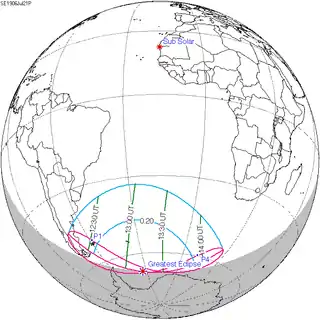 Partial |
120 | January 14, 1907 Total | |
| 125 | July 10, 1907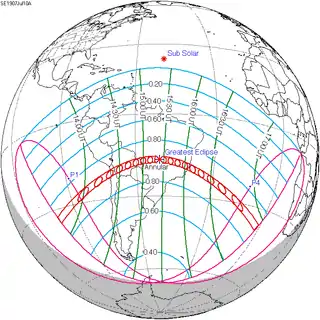 Annular |
130 | January 3, 1908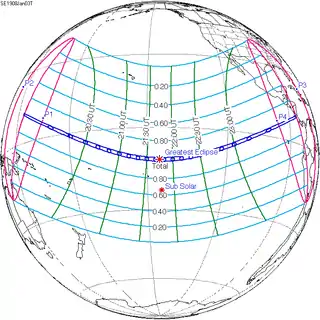 Total | |
| 135 | June 28, 1908 Annular |
140 | December 23, 1908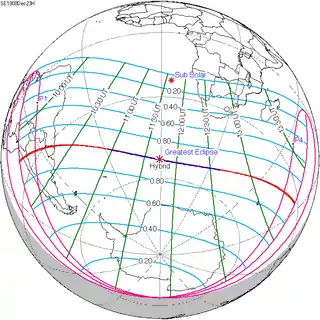 Hybrid | |
| 145 | June 17, 1909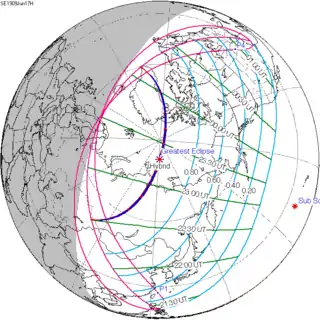 Hybrid |
150 | December 12, 1909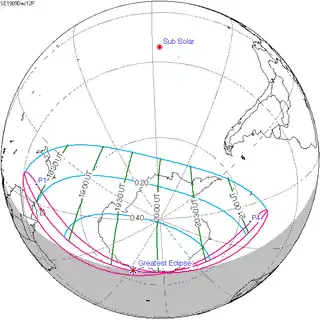 Partial | |
Saros 120
This eclipse is a part of Saros cycle 120, repeating every 18 years, 11 days, containing 71 events. The series started with partial solar eclipse on May 27, 933 AD, and reached an annular eclipse on August 11, 1059. It was a hybrid event for 3 dates: May 8, 1510, through May 29, 1546, and total eclipses from June 8, 1564, through March 30, 2033. The series ends at member 71 as a partial eclipse on July 7, 2195. The longest duration of totality was 2 minutes, 50 seconds on March 9, 1997. All eclipses in this series occurs at the Moon’s descending node.
| Series members 55–65 occur between 1901 and 2100 | ||
|---|---|---|
| 55 | 56 | 57 |
 January 14, 1907 |
 January 24, 1925 |
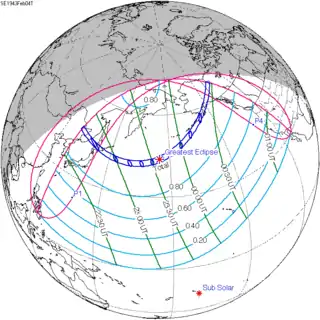 February 4, 1943 |
| 58 | 59 | 60 |
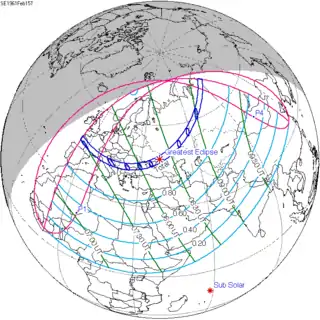 February 15, 1961 |
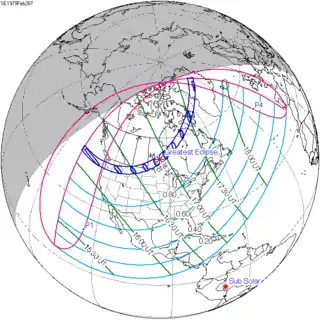 February 26, 1979 |
 March 9, 1997 |
| 61 | 62 | 63 |
 March 20, 2015 |
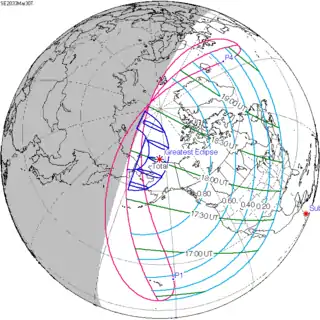 March 30, 2033 |
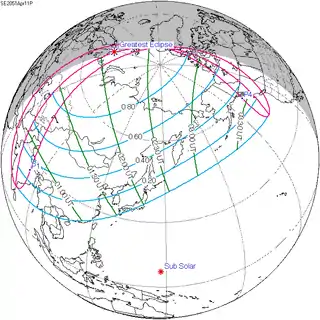 April 11, 2051 |
| 64 | 65 | |
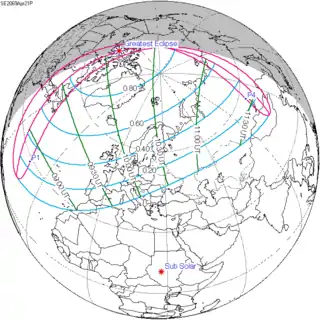 April 21, 2069 |
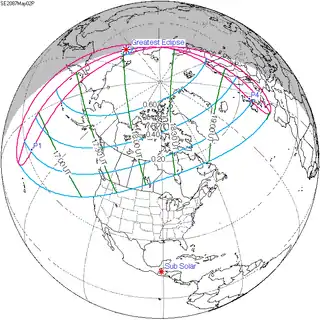 May 2, 2087 | |
Notes
- 1 2 "Yesterday's Eclipse of the Sun". The Guardian. 1907-01-15.
- 1 2 3 4 5 "Total Eclipse of the Sun on Jan. 13". The Morning Post. Camden, New Jersey. 1907-01-15. p. 8. Retrieved 2023-10-19 – via Newspapers.com.
- ↑ "To Observe Eclipse". The Roanoke Times. Roanoke, Virginia. 1907-01-15. p. 2. Retrieved 2023-10-15 – via Newspapers.com.
- ↑ "The Eclipse Yesterday". Nanaimo Daily News. Nanaimo, British Columbia, Canada. 1907-01-15. p. 2. Retrieved 2023-10-19 – via Newspapers.com.
- ↑ https://www.newspapers.com/article/the-daily-telegraph-ameer-in-india-moto/133686529/
- 1 2 "Ameer in India. Motor-car and balloon experiences". The Daily Telegraph. London, Greater London, England. 1907-01-15. p. 9. Retrieved 2023-10-19 – via Newspapers.com.
- ↑ "Eclipse of the sun". Western Mail. Cardiff, South Glamorgan, Wales. 1907-01-15. p. 5. Retrieved 2023-10-19 – via Newspapers.com.
- ↑ van Gent, R.H. "Solar- and Lunar-Eclipse Predictions from Antiquity to the Present". A Catalogue of Eclipse Cycles. Utrecht University. Retrieved 6 October 2018.
External links
- Earth visibility chart and eclipse statistics Eclipse Predictions by Fred Espenak, NASA/GSFC
.jpg.webp)

